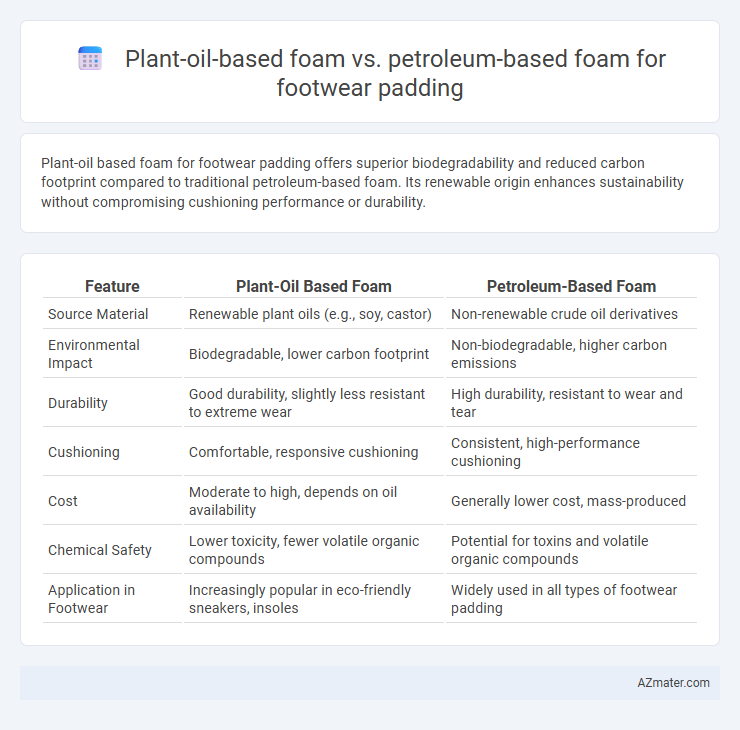Plant-oil based foam for footwear padding offers superior biodegradability and reduced carbon footprint compared to traditional petroleum-based foam. Its renewable origin enhances sustainability without compromising cushioning performance or durability.
Table of Comparison
| Feature | Plant-Oil Based Foam | Petroleum-Based Foam |
|---|---|---|
| Source Material | Renewable plant oils (e.g., soy, castor) | Non-renewable crude oil derivatives |
| Environmental Impact | Biodegradable, lower carbon footprint | Non-biodegradable, higher carbon emissions |
| Durability | Good durability, slightly less resistant to extreme wear | High durability, resistant to wear and tear |
| Cushioning | Comfortable, responsive cushioning | Consistent, high-performance cushioning |
| Cost | Moderate to high, depends on oil availability | Generally lower cost, mass-produced |
| Chemical Safety | Lower toxicity, fewer volatile organic compounds | Potential for toxins and volatile organic compounds |
| Application in Footwear | Increasingly popular in eco-friendly sneakers, insoles | Widely used in all types of footwear padding |
Introduction to Footwear Padding Foams
Plant-oil based foams for footwear padding utilize renewable materials like soybean or castor oil, offering enhanced biodegradability and reduced carbon footprint compared to petroleum-based foams. Petroleum-based foams, derived from fossil fuels, provide consistent cushioning and durability but contribute to environmental pollution and nonrenewable resource depletion. Advances in bio-based foam technology are closing the performance gap, making plant-oil foams increasingly viable for sustainable footwear manufacturing.
Overview of Plant-Oil Based Foam Technology
Plant-oil based foam technology utilizes renewable, bio-derived materials such as soybean, castor, or palm oil to create eco-friendly cushioning for footwear padding. This foam exhibits comparable durability, flexibility, and shock absorption properties to traditional petroleum-based foam, while significantly reducing carbon footprint and reliance on fossil fuels. Advances in polymer chemistry enable enhanced cell structure control, resulting in lightweight, breathable, and biodegradable foam options tailored for sustainable footwear applications.
Petroleum-Based Foam: Traditional Choice in Footwear
Petroleum-based foam remains the traditional choice in footwear padding due to its durability, cushioning properties, and cost-effectiveness. It offers consistent shock absorption and retains its structural integrity under prolonged use, making it a reliable material for various footwear applications. However, environmental concerns and non-renewable resource dependence have driven interest toward alternative materials like plant-oil based foams.
Environmental Impact Comparison
Plant-oil based foam for footwear padding significantly reduces carbon emissions compared to petroleum-based foam, as it derives from renewable resources like soy or castor beans that absorb CO2 during growth. Unlike petroleum-based foams, which rely on non-renewable fossil fuels and emit volatile organic compounds (VOCs) during production and degradation, plant-oil foams offer better biodegradability and lower toxicity. This shift supports sustainable manufacturing by minimizing ecological footprint and promoting circular economy practices in the footwear industry.
Performance and Comfort: Plant vs Petroleum
Plant-oil based foam offers superior breathability and moisture-wicking properties, enhancing overall foot comfort compared to petroleum-based foam. Performance-wise, plant-oil foam demonstrates better resilience and cushioning through natural elasticity, reducing foot fatigue during extended wear. Petroleum-based foam tends to retain heat and lacks biodegradability, contributing to decreased comfort and environmental concerns in footwear padding.
Cost Analysis and Market Availability
Plant-oil based foams for footwear padding typically incur higher production costs due to raw material extraction and processing complexities, yet benefit from increasing consumer demand for sustainable products that can drive premium pricing. Petroleum-based foams dominate the market with established supply chains and lower manufacturing expenses, offering cost-effective solutions widely available for mass production. Market availability favors petroleum-based foams currently, but growing environmental regulations and shifting consumer preferences are expanding the accessibility and competitiveness of plant-oil based alternatives in footwear padding applications.
Durability and Longevity in Footwear Use
Plant-oil based foam exhibits superior durability and longevity in footwear padding due to its enhanced resistance to compression set and oxidative degradation compared to petroleum-based foam. The renewable polyols derived from plant oils contribute to a more resilient cellular structure, improving cushioning retention over extended wear periods. In contrast, petroleum-based foams tend to degrade faster under repeated stress, leading to reduced padding lifespan and compromised footwear comfort.
Health and Safety Aspects for Consumers
Plant-oil based foam for footwear padding offers a non-toxic alternative to petroleum-based foam, reducing exposure to harmful volatile organic compounds (VOCs) and carcinogenic substances linked to synthetic materials. This bio-based foam enhances indoor air quality and minimizes skin irritation risks, promoting overall consumer health and safety. Furthermore, plant-oil foams exhibit improved biodegradability, lowering long-term environmental health impacts associated with disposal of petroleum-derived foams.
Innovation Trends in Sustainable Footwear Materials
Plant-oil based foams for footwear padding leverage renewable resources like soybean and castor oils, reducing reliance on fossil fuels and lowering carbon footprints. Innovations in bio-polyols and green chemistry enhance the durability, flexibility, and comfort of plant-derived foams, making them competitive with traditional petroleum-based foams. Increasing adoption of these plant-oil foams aligns with industry trends emphasizing circular economy principles, biodegradability, and reduced environmental impact in sustainable footwear material development.
Future Outlook: Moving Towards Greener Footwear Solutions
Plant-oil based foam offers a sustainable alternative to petroleum-based foam in footwear padding, reducing reliance on fossil fuels and decreasing the carbon footprint of shoe manufacturing. Innovations in bio-based polymers and renewable raw materials are driving enhanced durability and comfort in plant-oil foams, aligning with increasing consumer demand for eco-friendly products. The footwear industry is expected to accelerate the adoption of greener materials, supported by regulatory pressures and a global shift towards circular economy practices.

Infographic: Plant-oil based foam vs Petroleum-based foam for Footwear padding
 azmater.com
azmater.com